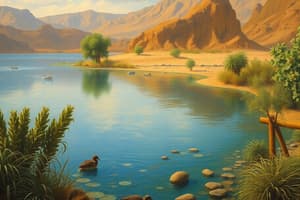Podcast
Questions and Answers
What percentage of the planet is covered in freshwater?
What percentage of the planet is covered in freshwater?
- 4%
- 1% (correct)
- 3%
- 2%
Which biome is the largest, covering 360 million km$^2$?
Which biome is the largest, covering 360 million km$^2$?
- Rivers
- Open ocean (correct)
- Marshes and swamps
- Lakes
Which zone is characterized by habitat off the bottom of the ocean?
Which zone is characterized by habitat off the bottom of the ocean?
- Pelagic (correct)
- Intertidal
- Neritic
- Benthic
Which hydrological reservoir has the longest cycle time of 3,100 years?
Which hydrological reservoir has the longest cycle time of 3,100 years?
What percentage of the world's fresh surface water is contained in the Great Lakes?
What percentage of the world's fresh surface water is contained in the Great Lakes?
What abiotic factor in lakes and ponds affects the permeability of water over long timescales?
What abiotic factor in lakes and ponds affects the permeability of water over long timescales?
What is the primary cause of turnover in lakes and ponds?
What is the primary cause of turnover in lakes and ponds?
Where do peatlands cover over 80% of their area?
Where do peatlands cover over 80% of their area?
What are the two types of peatlands mentioned in the text?
What are the two types of peatlands mentioned in the text?
What is a significant role of peatlands mentioned in the text?
What is a significant role of peatlands mentioned in the text?
What is a common biotic factor in peatlands mentioned in the text?
What is a common biotic factor in peatlands mentioned in the text?
What poses serious challenges to peatlands according to the text?
What poses serious challenges to peatlands according to the text?
What is the primary human influence on lakes and ponds mentioned in the text?
What is the primary human influence on lakes and ponds mentioned in the text?
What affects the stability of still water in peatlands?
What affects the stability of still water in peatlands?
What type of water body are fens potentially connected to?
What type of water body are fens potentially connected to?
What is the primary abiotic factor influencing water movement in lakes and ponds?
What is the primary abiotic factor influencing water movement in lakes and ponds?
Flashcards are hidden until you start studying
Study Notes
Aquatic Ecosystems Overview
- The world's freshwater is primarily concentrated in a few large lakes, with the Great Lakes containing approximately 20% of the world's fresh surface water.
- Lakes and ponds share similarities with oceans on a smaller scale and can have river-like littoral and riparian zones.
- Presence of a thermocline in the metalimnion affects the permeability of water over long timescales, leading to pond succession.
- Abiotic factors in lakes and ponds include light variability, thermal stratification, limited water movement due to temperature stratification or freezing, low salinity, and variable oxygen levels.
- Seasonality causes turnover in lakes and ponds, influencing abiotic factors such as light, temperature, water movement, salinity, and oxygen.
- Human influence on lakes and ponds is overwhelmingly negative, resulting from pollution, agricultural runoff, toxic waste, and species introductions.
- Peatlands cover over 5% of the world's land, with 80% occurring at high latitudes, and 15% in Canada, and play a significant role in carbon sequestration.
- Bogs and fens are two types of peatlands, with bogs being fed by precipitation and fens potentially connected to other water bodies.
- Abiotic factors in peatlands, bogs, and fens include light variability, temperature dependence on vegetation and water depth, still water stability, low salinity, and critical pH levels.
- Dominant moss layers and carnivorous plants are common biotic factors in peatlands, with peat extraction posing serious challenges due to its destructive nature and the impact of climate change on carbon stores.
- Assigned reading covers the topics discussed, aiming to reinforce understanding of the concepts related to aquatic ecosystems.
Studying That Suits You
Use AI to generate personalized quizzes and flashcards to suit your learning preferences.




